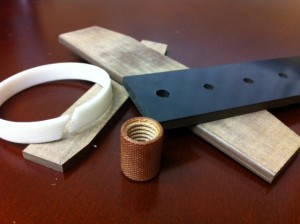This unique family of materials maintains its dimensional stability at elevated temperatures while most thermoplastics melt at elevated temperatures. The formation of these materials involves a base substrate such as canvas, linen, paper, or glass cloth being coated with an adhesive or epoxy. This is done repeatedly to create layers of material that are pressed into sheet form with heat and pressure. Due to this lamination process, these materials possess both excellent electrical insulation properties as well as incredible compressive strength.
G10 and G11 are widely used in electrical insulation applications where high heat resistance, mechanical stability, and high strength are needed. G10 is also widely used in cryogenic applications due to its ability to handle sub-zero temperatures. Common applications include pipe supports, spacers, insulators, and terminal boards.
Phenolics are among the oldest “plastics” on the market today. They are dimensionally stable, possess excellent electrical properties, and have an amazing amount of compressive strength. Common applications include electrical insulators, terminal blocks, grating, switches, switchboard panels, circuit breaker parts, and support structures do to their ability to handle excessive weight.
GPO-3 or “Glastic” is the go-to material for electrical applications that require high arc protection, low flammability, and good mechanical strength. Most commonly found in bus bar supports and in switchgear acting as a current barrier or mounting panel, this material is best suited for high voltage applications.
Material Names:
G10 – Glass Epoxy Laminate
G11 – Glass Epoxy Laminate
Phenolic CE – Canvas
Phenolic LE – Linen
Phenolic Paper Grades – X, XX, XXX
GPO-3 or Glastic™
